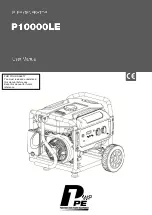
21
4.12.5 Grounding/Earthing Requirements:
The frame of the generating set must be connected
to an earth ground. Since the set is mounted on
vibration isolators, the ground connection must be
flexible to avoid possible breakage due to vibration.
Ground connection cables or straps should have at
least full load current carrying capacity and meet
applicable regulations.
4.12.6 Alternator Reconnection:
Most
alternators can be reconnected to suit different
output voltages. Ensure that all other components
such as circuit breakers, current transformers, cables
and ammeters are suitable before operating at a
different voltage.
4.12.7 Parallel Running:
Extra equipment must
be fitted for the standard generating sets to be
operated in parallel with other generating sets or
with mains power.
4.12.8 Insulation Test:
Before starting the
generating set after installation, test the insulation
resistance of the windings. The Automatic Voltage
Regulator (AVR) should be disconnected and the
rotating diodes either shorted out with temporary
links or disconnected. Any control wiring must also
be disconnected.
A 500V Megger or similar instrument should be
used. Disconnect any earthing conductor connected
between neutral and earth and megger an output
terminal to earth. The insulation resistance should
be in excess of 1Mý to earth. Should the insulation
resistance be less than 1Mý the winding must be
dried out.
Control of generating set noise is becoming very
important in most installations. There is a range of
components available to control the noise level.
WARNING
Ear protection must be worn when operating or
working around an operating generating set.
4.13.1 Exhaust Silencers:
As discussed in Section
4.8 the exhaust silencer will decrease sound levels
from the engine.
4.13.2 Canopies:
Section 4.2 discusses sound
attenuating canopies that lower the noise level of
the entire generating set.
4.13.3 Other Sound Attenuation:
For
installations in buildings there are other types of
equipment such as acoustic louvers, splitter vents
and fan silencers, as well as
4.13 ACOUSTIC SILENCING
sound absorbing wall coverings, that can be used to
reduce the noise levels of generating sets.
Jacket water heater is used in order to startup the
generating set more easily and to take the load. In
automatic generating sets jacket water heater is
standard. In manual type generating sets it is an
option. Heater warms up the jacket water of the
engine when the generating set is not working.
4.15.1 Preparing to Tow:
Inspect all components
of the coupling equipment on the towing vehicle
and the generating set for defects such as excessive
wear, corrosion, cracks, bent metal, or loose bolts.
Inspect tyres for condition and proper inflation.
Check that all tail lights, if equipped, are operating
properly and that all reflectors are clean and
functional.
4.15.2 Towing:
Whenever towing a mobile
generating set, remember that manoeuvra-bility and
stopping distance will be affected by the weight of
the trailer.
WARNING
When towing mobile generating set, observe all
Codes, Standards or other regulations and traffic
laws. These include those regulations specifying
required equipment and maximum and minimum
speeds.
Do not permit personnel to ride on the mobile
generating set. Do not permit personnel to stand
or ride on the drawbar or to stand or walk between
the generating set and the towing vehicle.
Avoid gradients and avoid potholes, rocks or other
obstructions and soft or unstable terrain.
Ensure the area behind and under the mobile set is
clear before reversing.
4.15.3 Parking:
Park the set on a dry level area
that can support its weight. If it must be located on
a slope, park it across the grade so that it does not
tend to roll downhill. Do not park the set on grades
exceeding 15°.
Long term storage can have detrimental effects on
both the engine and alternator. These effects can
be minimized by properly preparing and storing the
generating set.
4.14 ENGINE JACKET WATER HEATER
4.15. TOWING (Mobile Generating Sets)
4.16 STORAGE
4.16.1 Engine Storage:
The engine should be
put through an engine preservation procedure
that includes cleaning the engine and replacing all
the fluids with new or preserving fluids.
















































